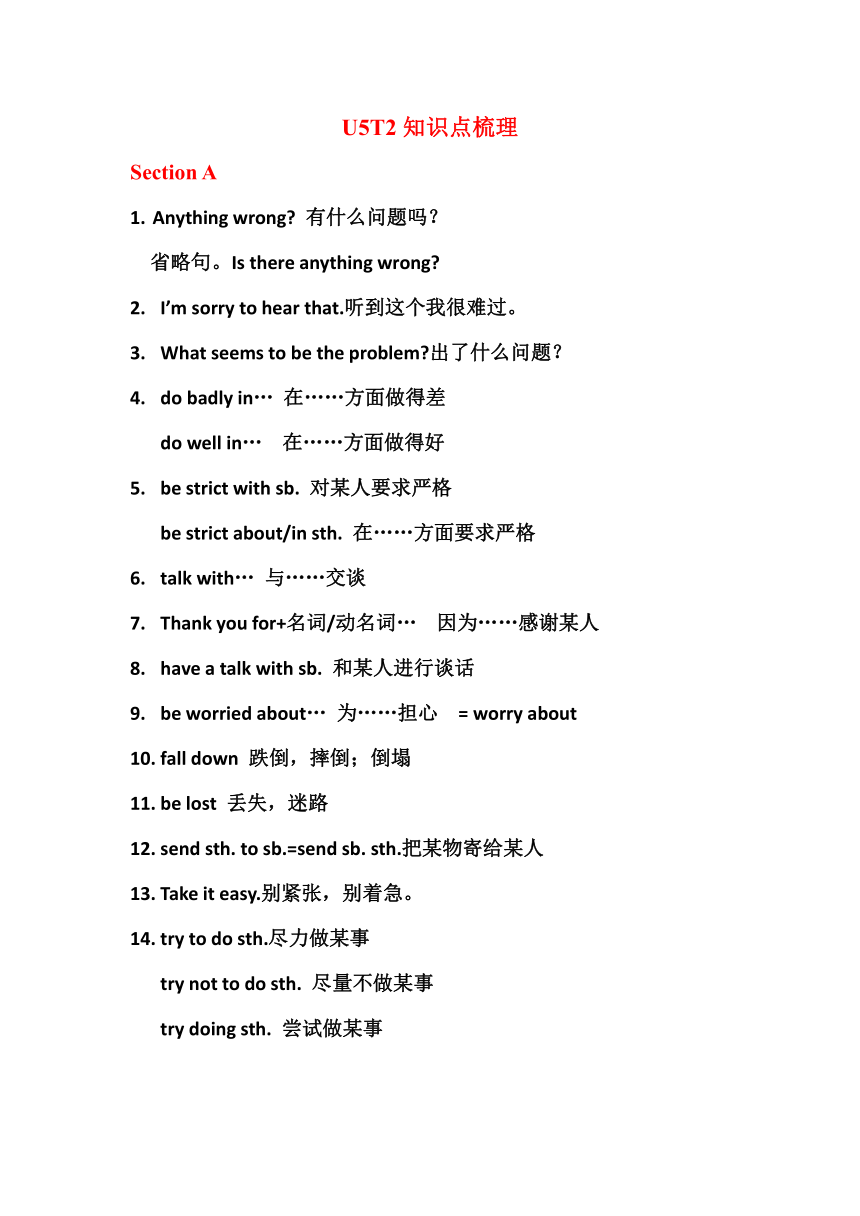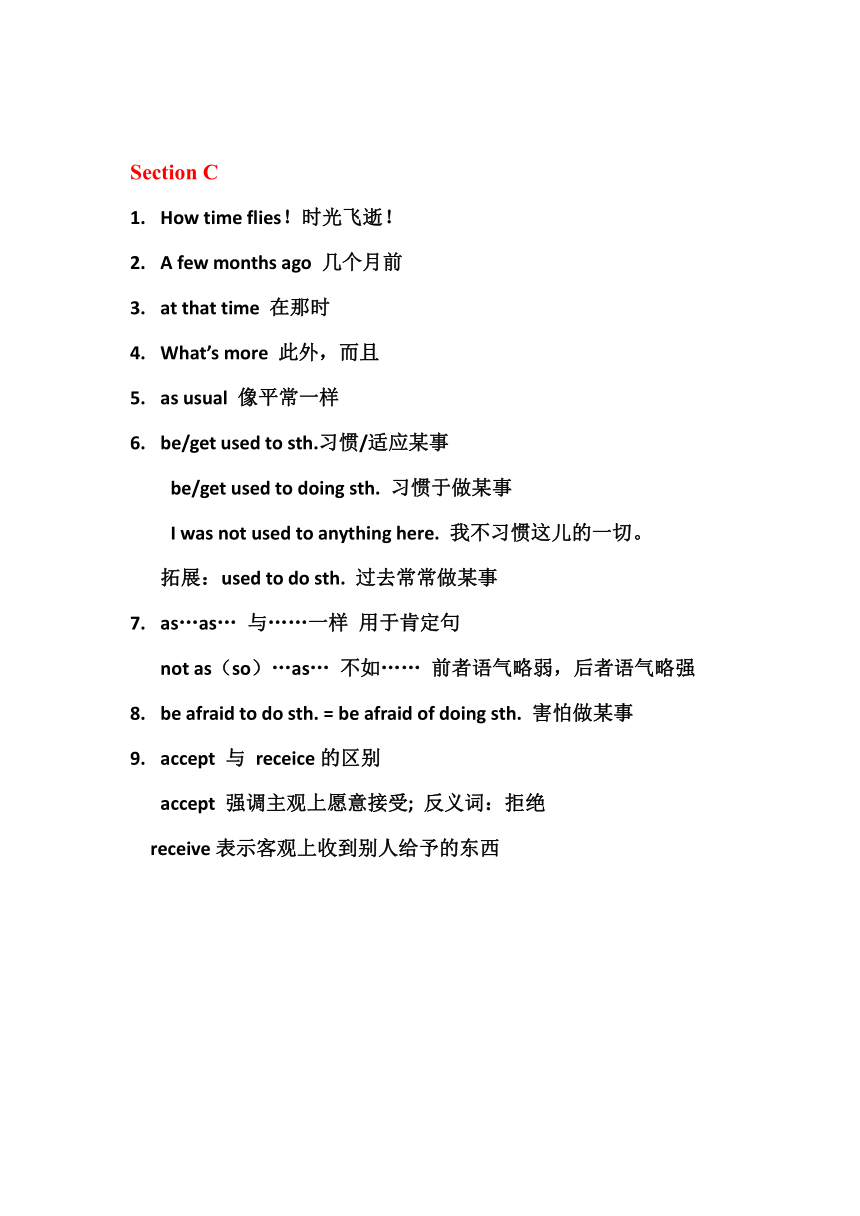Unit 5 Feeling excited Topic2知识点梳理 仁爱版八年级英语下册
文档属性
| 名称 | Unit 5 Feeling excited Topic2知识点梳理 仁爱版八年级英语下册 |  | |
| 格式 | docx | ||
| 文件大小 | 17.9KB | ||
| 资源类型 | 教案 | ||
| 版本资源 | 仁爱科普版 | ||
| 科目 | 英语 | ||
| 更新时间 | 2024-03-14 13:43:30 | ||
图片预览



文档简介
U5T2知识点梳理
Section A
Anything wrong 有什么问题吗?
省略句。Is there anything wrong
I’m sorry to hear that.听到这个我很难过。
What seems to be the problem 出了什么问题?
do badly in… 在……方面做得差
do well in… 在……方面做得好
be strict with sb. 对某人要求严格
be strict about/in sth. 在……方面要求严格
talk with… 与……交谈
Thank you for+名词/动名词… 因为……感谢某人
have a talk with sb. 和某人进行谈话
be worried about… 为……担心 = worry about
fall down 跌倒,摔倒;倒塌
be lost 丢失,迷路
send sth. to sb.=send sb. sth.把某物寄给某人
Take it easy.别紧张,别着急。
try to do sth.尽力做某事
try not to do sth. 尽量不做某事
try doing sth. 尝试做某事
Section B
How are you feeling today 你今天感觉怎么样?
fail v. 不及格;失败;未做 failure n. 失败;故障;失败者;破产
fail to do sth. 未能做成某事
someone 某人 用于肯定句或征求意见的疑问句中
at one’s age 在某人的年龄时
at the age of… 在……岁时
make friends with…与……交朋友
make sb. do sth. 让某人做某事
be sure+that 从句
be sure of+名词 对……有把握
be sure to do sth. 一定会做某事
by the way 顺便提一下;捎带说一声
let sb. do sth. 让某人做某事
find/feel/think +it +adj.+to do sth.发现/感觉/认为做某事怎么样
be kind to sb, 对某人友善
Help sb. With sth. 在某方面帮助某人
help sb. (to)do sth. 帮助某人做某事
ask…for help 请求帮助
Section C
How time flies!时光飞逝!
A few months ago 几个月前
at that time 在那时
What’s more 此外,而且
as usual 像平常一样
be/get used to sth.习惯/适应某事
be/get used to doing sth. 习惯于做某事
I was not used to anything here. 我不习惯这儿的一切。
拓展:used to do sth. 过去常常做某事
as…as… 与……一样 用于肯定句
not as(so)…as… 不如…… 前者语气略弱,后者语气略强
be afraid to do sth. = be afraid of doing sth. 害怕做某事
accept 与 receice的区别
accept 强调主观上愿意接受; 反义词:拒绝
receive表示客观上收到别人给予的东西
Section D
deal with 处理,解决,对付
all the time 一直
for example 例如 such as 像……
learn……from x向某人学习
go mad 发疯
elder 只能用在表示称谓的名词前表示长幼关系,不可做表语。
refuse to do sth.拒绝做某事
instead相反,代替
even though=even if 即使
not…any longer = no longer 不再 指时间上不再延长,多与持续性动词连用
not…any more=no more 不再 指做事的次数不再增加,多与短暂性动词连用
You will not see him any more.
Grammar
原因状语从句
because, as, for, since这几个词都是表示“原因”的连词,语气由强至弱依次为:because→since→as→for;其中because, since, as均为从属连词,引导原因状语从句;而for 是并列连词,引导并列句。
1. because表示直接原因,其语气最强。常用来回答why的提问,一般放于主句之后,也可以单独存在。例:
1) I stayed at home because it rained. 因为下雨我呆在家里。
2)—Why is she absent 她为什么缺席?
—Because she is sick. 因为她病了。
2. since侧重主句,从句表示显然的或已为人所知的理由,常译为“因为”、“既然”,语气比because稍弱,通常置于句首。
例: Since everyone is here, let's start. 既然大家都到齐了,我们就出发吧!
3. as是常用词,表示双方已知的事实或显而易见的原因,或者理由不是很重要,含义与since相同,但语气更弱,没有since正式。
例: As I had a cold, I didn’t go to school. 因为我感冒了,所以没去上学。
4. for用作连词时,与because相似,但它所表示的原因往往是上文未交待过的情况,它所引导的分句只能放在句子后部(或单独成为一个句子),且for不可置于句首。
例:
1) The days are short, for it is now December. 白天短了,因为现在已是十二月份。
2) It must have rained, for the ground is wet. (从“地面潮湿”作出“下过雨”的推测,但地湿并不一定是下雨所致, for不可以换为because。)
二、同级比较
1. “as +原级形容词+as”的结构,表示前后两者的情况一样。
1)A+系动词+as+形容词原级+as+ B
eg.
My handwriting is as beautiful as yours. 我的书法和你的一样好。
2)A+谓语动词+as+副词原级+as+ B
eg. Lucy speaks Chinese as well as Lily.
2. 在否定句中,用"not as/ so +原级形容词as"结构,表示前者不如后者。
1) A+系动词+not as/so+形容词原级+as十B
eg.
These books aren't as interesting as those.
I am not as/ so busy as I used to be.
2) A+助动词/情态动词+not+谓语动词+as/so+ B
eg.
She didn't sing so well that night as she usually does.
3. 如果第一个as/ so后的形容词作定语修饰名词,应将该名词及有关修饰语都放在第一个as/ so之后。
eg.
We have produced as many tractors as we did last year. 我们生产的拖拉机和去年一样多。
Section A
Anything wrong 有什么问题吗?
省略句。Is there anything wrong
I’m sorry to hear that.听到这个我很难过。
What seems to be the problem 出了什么问题?
do badly in… 在……方面做得差
do well in… 在……方面做得好
be strict with sb. 对某人要求严格
be strict about/in sth. 在……方面要求严格
talk with… 与……交谈
Thank you for+名词/动名词… 因为……感谢某人
have a talk with sb. 和某人进行谈话
be worried about… 为……担心 = worry about
fall down 跌倒,摔倒;倒塌
be lost 丢失,迷路
send sth. to sb.=send sb. sth.把某物寄给某人
Take it easy.别紧张,别着急。
try to do sth.尽力做某事
try not to do sth. 尽量不做某事
try doing sth. 尝试做某事
Section B
How are you feeling today 你今天感觉怎么样?
fail v. 不及格;失败;未做 failure n. 失败;故障;失败者;破产
fail to do sth. 未能做成某事
someone 某人 用于肯定句或征求意见的疑问句中
at one’s age 在某人的年龄时
at the age of… 在……岁时
make friends with…与……交朋友
make sb. do sth. 让某人做某事
be sure+that 从句
be sure of+名词 对……有把握
be sure to do sth. 一定会做某事
by the way 顺便提一下;捎带说一声
let sb. do sth. 让某人做某事
find/feel/think +it +adj.+to do sth.发现/感觉/认为做某事怎么样
be kind to sb, 对某人友善
Help sb. With sth. 在某方面帮助某人
help sb. (to)do sth. 帮助某人做某事
ask…for help 请求帮助
Section C
How time flies!时光飞逝!
A few months ago 几个月前
at that time 在那时
What’s more 此外,而且
as usual 像平常一样
be/get used to sth.习惯/适应某事
be/get used to doing sth. 习惯于做某事
I was not used to anything here. 我不习惯这儿的一切。
拓展:used to do sth. 过去常常做某事
as…as… 与……一样 用于肯定句
not as(so)…as… 不如…… 前者语气略弱,后者语气略强
be afraid to do sth. = be afraid of doing sth. 害怕做某事
accept 与 receice的区别
accept 强调主观上愿意接受; 反义词:拒绝
receive表示客观上收到别人给予的东西
Section D
deal with 处理,解决,对付
all the time 一直
for example 例如 such as 像……
learn……from x向某人学习
go mad 发疯
elder 只能用在表示称谓的名词前表示长幼关系,不可做表语。
refuse to do sth.拒绝做某事
instead相反,代替
even though=even if 即使
not…any longer = no longer 不再 指时间上不再延长,多与持续性动词连用
not…any more=no more 不再 指做事的次数不再增加,多与短暂性动词连用
You will not see him any more.
Grammar
原因状语从句
because, as, for, since这几个词都是表示“原因”的连词,语气由强至弱依次为:because→since→as→for;其中because, since, as均为从属连词,引导原因状语从句;而for 是并列连词,引导并列句。
1. because表示直接原因,其语气最强。常用来回答why的提问,一般放于主句之后,也可以单独存在。例:
1) I stayed at home because it rained. 因为下雨我呆在家里。
2)—Why is she absent 她为什么缺席?
—Because she is sick. 因为她病了。
2. since侧重主句,从句表示显然的或已为人所知的理由,常译为“因为”、“既然”,语气比because稍弱,通常置于句首。
例: Since everyone is here, let's start. 既然大家都到齐了,我们就出发吧!
3. as是常用词,表示双方已知的事实或显而易见的原因,或者理由不是很重要,含义与since相同,但语气更弱,没有since正式。
例: As I had a cold, I didn’t go to school. 因为我感冒了,所以没去上学。
4. for用作连词时,与because相似,但它所表示的原因往往是上文未交待过的情况,它所引导的分句只能放在句子后部(或单独成为一个句子),且for不可置于句首。
例:
1) The days are short, for it is now December. 白天短了,因为现在已是十二月份。
2) It must have rained, for the ground is wet. (从“地面潮湿”作出“下过雨”的推测,但地湿并不一定是下雨所致, for不可以换为because。)
二、同级比较
1. “as +原级形容词+as”的结构,表示前后两者的情况一样。
1)A+系动词+as+形容词原级+as+ B
eg.
My handwriting is as beautiful as yours. 我的书法和你的一样好。
2)A+谓语动词+as+副词原级+as+ B
eg. Lucy speaks Chinese as well as Lily.
2. 在否定句中,用"not as/ so +原级形容词as"结构,表示前者不如后者。
1) A+系动词+not as/so+形容词原级+as十B
eg.
These books aren't as interesting as those.
I am not as/ so busy as I used to be.
2) A+助动词/情态动词+not+谓语动词+as/so+ B
eg.
She didn't sing so well that night as she usually does.
3. 如果第一个as/ so后的形容词作定语修饰名词,应将该名词及有关修饰语都放在第一个as/ so之后。
eg.
We have produced as many tractors as we did last year. 我们生产的拖拉机和去年一样多。
同课章节目录
- Unit 5 Feeling excited
- Topic 1 You look excited
- Topic 2 I’m feeling better now.
- Topic 3 Many things can affect our feelings.
- Unit 6 Enjoying Cycling
- Topic 1 We're going on a three-day visit to Mount
- Topic 2 How about exploring Tian’anmen Square?
- Topic 3 Bicycle riding is good exercise.
- Unit 7 Food festival
- Topic 1 We’re preparing for a food festival.
- Topic 2 I’m not sure whether I can cook it well.
- Topic 3 I Cooked the Most Successfully
- Unit 8 Our Clothes
- Topic 1 We will have a class fashion show.
- Topic 2 We can design our own uniforms.
- Topic 3 He said the fashion show was wonderful.
